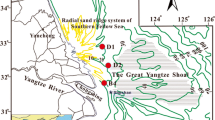Abstract
Surface accumulations of foam and flotsam as well as sharp salinity, density, turbidity gradients and regions of acoustic scatter were characteristic of ebb-tidal fronts in Charleston Harbor, South Carolina. Surface convergence velocities at these fronts averaged 0.06 m s−1 into the front at an angle of 30° to 60° with respect to the frontal axis, indicating along-front transport during the ebb. These fronts are tidally-induced, forming on the late flood and ebb along the interfaces of water masses. Horizontal and vertical measurements of density revealed that the upper harbor fronts form along the margin of a freshwater lens produced by riverine input. The hypothesis that these frontal zones have higher densities of phytoplankton and zooplankton than adjacent water masses was tested using chlorophylla measurements and net collections. The fronts did not demonstrate any significant accumulations of phytoplankton or zooplankton during the ebb tide. The results of this study suggest that the physical characteristics of ebb-tidal estuarine fronts in Charleston Harbor are periodic in nature and may indirectly affect plankton transport in this coastal plain estuary.
Similar content being viewed by others
Literature Cited
Booth, D. A. 1987. Some consequences of a flood tide front in Loch Creran.Estuarine Coastal Shelf Sci. 24:363–375.
Bowman, M. J. andW. E. Esalas. 1978. Proceedings of the workshop, p. 6–13.In M. J. Bowman and W. E. Esaias (eds.), Oceanic Fronts in Coastal Processes. Springer-Verlag, New York.
Brandt, S. B. andV. A. Wadley. 1981. Thermal fronts as ecotones and zoogeographic barriers in marine and freshwater systems.Proc Ecol. Soc. Aust. 11:13–26.
Conover, W. J. 1980. Practical Nonparametric Statistics. John Wiley and Sons, New York. 493 p.
Dustan, P. andJ. Pinckney. 1989. Tidally-induced estuarine phytoplankton patchiness.Limnol. Oceanogr. 34:408–417.
Farmer, D. M. andJ. D. Smith. 1980. Tidal interaction of stratified flow with a sill in Knight Inlet.Deep-Sea Res. 27:239–254.
Floodgate, G. D., G. E. Fogg, D. A. Jones, K. Lochte, andC. M. Turley. 1981. Microbiological and zooplankton activity at a front in Liverpool Bay.Nature 290:133–136.
Herbst, G. N., D. P. Weston, andJ. G. Lorman. 1979. The distributional response of amphipod and decapod crustaceans to a sharp thermal front north of Cape Hatteras, North Carolina.Bull. Biol. Soc. Wash. 3:118–213.
Huzzey, L. M. andJ. M. Brubaker. 1988. The formation of longitudinal fronts in a coastal plain estuary.J. Geophys. Res. 93:1329–1334.
Kiorboe, T. andK. Johansen. 1986. Studies of larval herring (Clupea harengus L.) patch in the Buchan area. IV. Zooplankton distribution and productivity in relation to hydrographic features.Dana 6:37–51.
Klemas, V. andD. F. Polis. 1977. Remote sensing of estuarine fronts and their effects on pollutants.Photogramm. Eng. Remote Sens. 43:599–612.
LeFevre, J. 1986. Aspects of the biology of frontal zones.Adv. Mar. Biol. 23:163–299.
Nunes, R. A. andJ. H. Simpson. 1985. Axial convergence in a well-mixed estuary.Estuarine Coastal Shelf Sci. 20:637–649.
Officer, C. B. 1976. Physical Oceanography of Estuaries. John Wiley and Sons, New York. 465 p.
Parsons, T. R., Y. Maita, andC. M. Lalli. 1984. A Manual of Chemical and Biological Methods for Seawater Analysis. Pergammon Press, New York. 173 p.
Seliger, H. H., K. R. McKinley, W. H. Biggley, R. B. Rivkin, andK. R. H. Aspden. 1981. Phytoplankton patchiness in frontal regions.Mar. Biol. 61:119–131.
Sick, L. V., C. C. Johnson, andR. Engel. 1978. Trace metal enhancement in the biotic and abiotic components of an estuarine tidal front.J. Geophys. Res. 83:4659–4667.
Simpson, J. H. andW. R. Turrell. 1986. Convergent fronts in the circulation of tidal estuaries, p. 139–152.In D. A. Wolfe (ed.), Estuarine Variability. Academic Press, New York.
Smith, R. C., P. Dustan, D. Au, K. S. Baker, andE. A. Dunlap. 1986. Distribution of cetaceans and sea-surface chlorophyll concentrations in the California Current.Mar. Biol. 91:385–402.
Szekielda, K. H., S. L. Kupperfman, V. Klemas, andD. F. Polis. 1972. Elemental enrichment in organic films and foam associated with aquatic frontal systems.J. Geophys. Res. 77:5278–5282.
Author information
Authors and Affiliations
Additional information
Grice Marine Biological Laboratory Contribution No. 83.
Rights and permissions
About this article
Cite this article
Pinckney, J., Dustan, P. Ebb-tidal fronts in Charleston Harbor, South Carolina: Physical and biological characteristics. Estuaries 13, 1–7 (1990). https://doi.org/10.2307/1351425
Received:
Accepted:
Issue Date:
DOI: https://doi.org/10.2307/1351425




